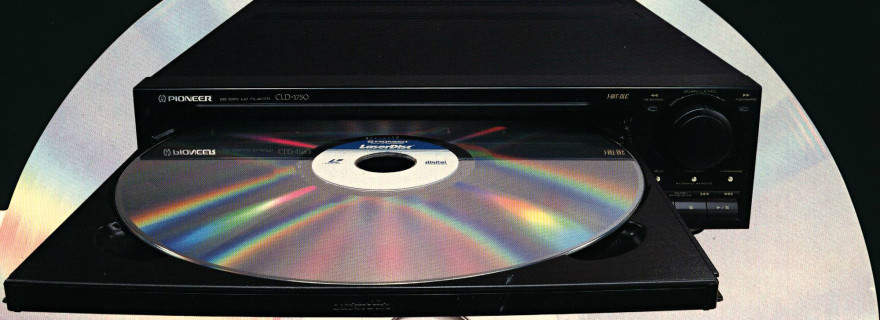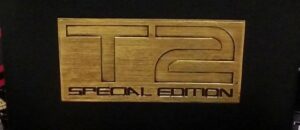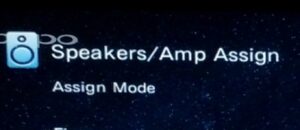Long before Blu-ray, before even DVD, the Laserdisc was king of the home theater world. Yet despite surviving for over twenty years, the venerable videodisc format never caught on with the mainstream, and most kids today have probably never even heard of it. Did you ever own a Laserdisc player?
At its peak in the mid-1990s, Laserdisc reached an adoption rate of a little less than 2% of American households. That’s a quite small fraction of even the niche status of Blu-ray today. Admittedly, there are good reasons why the public never embraced the format. The huge 12″ discs were clunky and cumbersome. At most, an LD could only hold one hour of video per side, which meant that every movie had to stop for at least one side break. Depending on the model of player you owned, this could mean a 7-15 second pause while the machine’s laser mechanism moved over to the other side, or could mean that you had to get out of your chair and physically flip over the disc. Movies longer than two hours (even if only one minute over two hours) had to be split to multiple discs. Releases in the slightly higher-quality CAV format only held 30 minutes of video per side. The Criterion Collection’s CAV box set edition of ‘Lawrence of Arabia’ had seven side changes! For average consumers, this seemed like a terrible inconvenience.
On top of that, price was a significant limitation. An entry-level LD player cost about $300. High-end models could run upwards of $1,500, and there was a significant difference in video quality from one model to another. The average Laserdisc release cost $34.99 to $39.99 for just the movie itself with little to no bonus features, while supplement-packed Special Editions (like those from Criterion) frequently ran over $100.
This was clearly not a product that appealed to the average Joe. Nevertheless, film buffs and video enthusiasts embraced Laserdisc for its (at the time) impressive picture and sound quality. No, judged by today’s standards, a Laserdisc will not hold up well on a big-screen HDTV, but compared to the dominant VHS format of the day (when viewed on televisions 36″ or less), Laserdisc was a revelation, with almost double the resolution of tape and crystal clear digital audio. The format also pioneered many features that we take for granted today on DVD and Blu-ray, including chapter stops, alternate soundtracks, multi-channel surround sound, audio commentaries and supplemental content.
I was first introduced to Laserdisc while in college. I had a work study job in my school’s media lab, where I had access to a couple of LD players that no teachers ever bothered to sign out, plus plenty of free time to sit around watching movies. Every weekday, I’d rent a couple of discs from a local shop called Laser Craze and watch two movies during my lazy evening shift.
After college, the future Mrs. Z bought me my first Laserdisc player (an entry-level Pioneer CLD-S201) for my birthday. Over the years, I upgraded through several models, culminating with the very expensive, monstrously huge HLD-X9, which I had to import from Japan. I also owned several hundred Laserdiscs.
Eventually, DVD took over. I was resistant at first, but (after a bumpy introduction) had to admit that the digital format exceeded Laserdisc’s quality in a much more convenient package. Then came Blu-ray, which leaves both DVD and Laserdisc in the dust. Honestly, it’s painful to try to watch a Laserdisc on my projector today.
I still have my HLD-X9, but I sold off (or gave away) a big chunk of my disc collection. Even after paring down, I still have about 200 discs that I keep around for sentimental reasons. I haven’t fired up the player in a very long time, and I may not anytime soon, but I like having it and the discs around.






Kevin Hawerchuk
My first laserdisc player was a basic Magnavox unit. Likely purchased in 1982 or 1983. I loved the format immensely. A nearby public library lent out laserdiscs so I had plenty of free movies to watch. I basically borrowed their entire collection over a period of many years, watching several per week. Eventually I moved up the ladder and at one point in time, had my hands on the cream of the laserdisc player crop. Here is a list of players I owned for weeks or many months: Pioneer HLD X9, Pioneer Elite 97, Elite 99, Elite 79, Elite 95. Pioneer LD S2 (huge single side reference player. Weighed 60 pounds.) Some esoteric jobs… Runco LJRII, MSB Silver, Faroudja LD1000. Some nice middle of the road units.. Pioneer CLD 1010, Panasonic LX900, Panasonic Prism LX1000, and the very last Pioneer laserdisc player from Japan, with the very last of their high-end comb filters.. the Pioneer R7G. Right now I am reduced to 4 laserdisc players. Two combo dvd/ld units. The DVL 700 and DVL 900. Two single side players too. The Pioneer CLD S104 and S201. I still have a collection of over 350 titles and just last night, I watched Whatever Happened To Baby Jane on laserdisc 🙂
Digital_Defector
LOL. The reason DVD and BLURAY is successful is because the average consumer has no idea what they are doing and do not care about the quality of their formats, they care about convenience. Which is perfectly right up dvd and bluray’s alley to be honest. But Laserdisc is higher quality than even bluray.
Bluray currently can only do 1080p. So that’s 1,080 colors per horizontal line of resolution. Laserdisc is analog and therefore is not limited to pixel resolution, it’s colors are well within MILLIONS OF COLORS per line of resolution. More colors = more detail.
I just can’t believe how willfully and jealously uneducated the masses are on the differences between digital and analog. Analog is superior because it does not limit the colors to square pixels, it allows capture of video information at the MOLECULAR level. Even 4k bluray is just that, 4k colors. Laserdisc still has millions. IF we compare DVD and Laserdisc for instance, 1 pixel on a dvd is one color. However this SAME EXACT SPACE on a laserdisc can contain hundreds and hundreds of different colors due to it being analog.
It is evident you all think CRTs are just crummy LCD tvs or something. That they have “pixels”. When even the industry giants of today consistently admit that CRT televisions are better at displaying everything, even HD video.
For some reason everything thinks the word “pixel” was invented during neolithic times and that it therefore applies to everything in video lol. They are completely in the dark about this old technology, willfully so. They like to bully vinyl/cassette lovers because HUH YOU QUESTIONED CEASARS NEW RULES HOW DARE YOU. They don’t understand that analog technology doesn’t have pixels at all and that pixels LIMIT the amount of colors on screen! You can only have 1 color per pixel at a time! ROFL
Seriously to any good ones out there just not in the know about AvD, i’m not tallking about you. I’m addressing the inevitable wife-beating bullies who will try to make someone (me) they don’t even know look crazy and stupid and deserving of banning. They are freaking everywhere. The type of people that call the cops on you if a napkin fell out of your trash can onto your driveway.
Elie Barnes
yes, i own a CLD-D704, purchased in 2013
Bestmowingplus Darryl
I have a disc player and original superman disc, wondering the value In today’s market, looking for a price for my brother.😊
Josh Zyber
AuthorIt’s probably not worth much, unfortunately. Check eBay for recent auctions.
Jimm
I remember AMAZING my best friends wife with the train crash in The Fugitive on Laserdisc through my surround sound system. Been a long time, so I am no longer sure, but I think it may have just been “Matrix” surround, but what the heck.
Jimm
Oh, BTW, 1080 and 4K do not refer to number of colors but to lines of resolution. A 1080p format produeces 1080 line of horizontal resolution that are scenned progressively rather than in an interlaced pattern.
Sheldon Cooper
I Love Laser Disc. I recently bought a player from Ebay and can hardly wait to get it. The analog transfer on Laser is the same way film was done. That explains the more theatrical feel you get from watching laser. The digital transfer takes away something on the older films that were not done in digital. Most films made before digital look better on laser and the picture is larger. Digital shrinks the film. All MGM films are much better on Laser and you get the theater experience!
Chris B
The Blu-Ray format presents classic films far closer to their original thatrical presentations far more than Laserdisc. I get why people love the format for nostalgic reasons, but it in no way compares to the HD options we have available today in terms of quality.